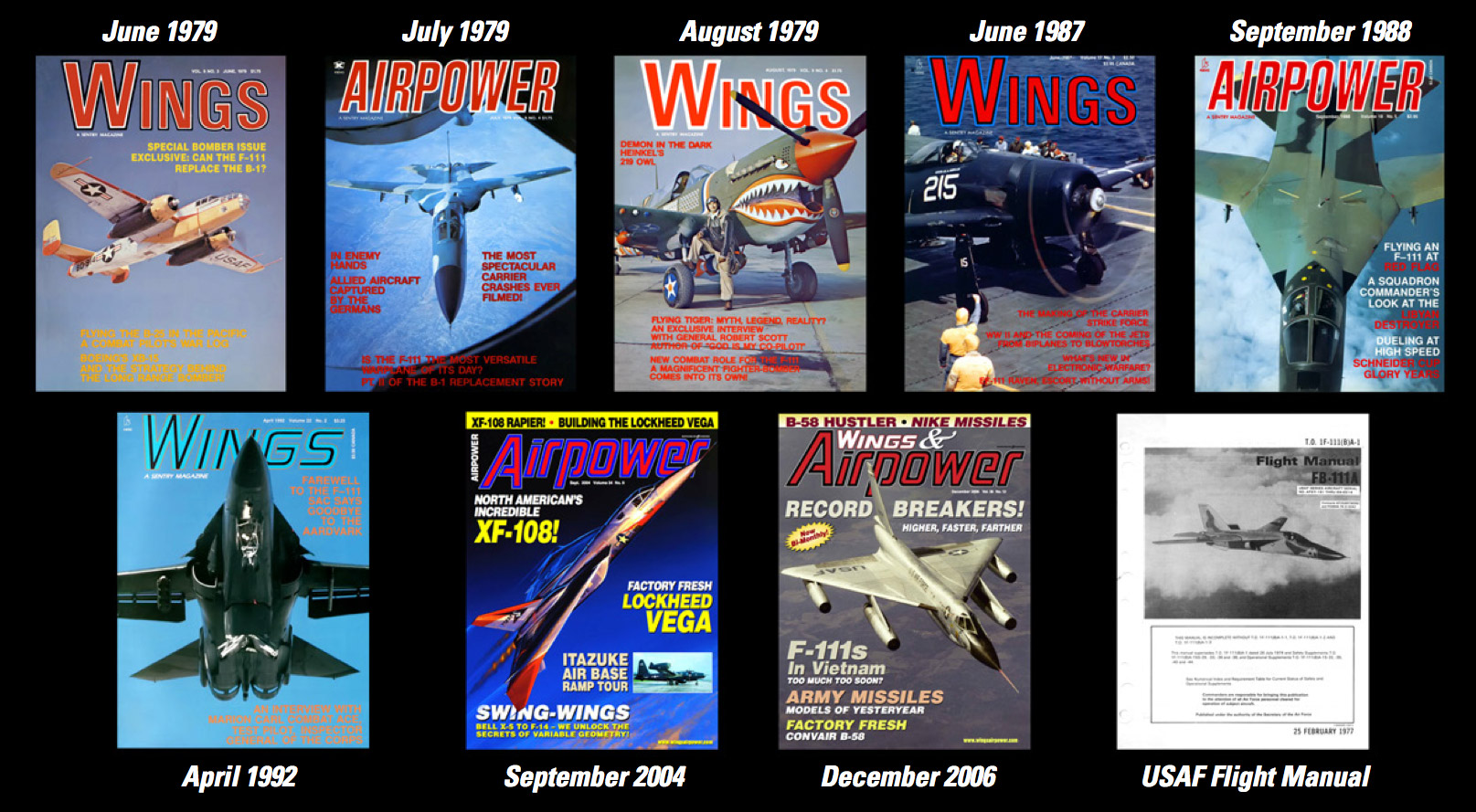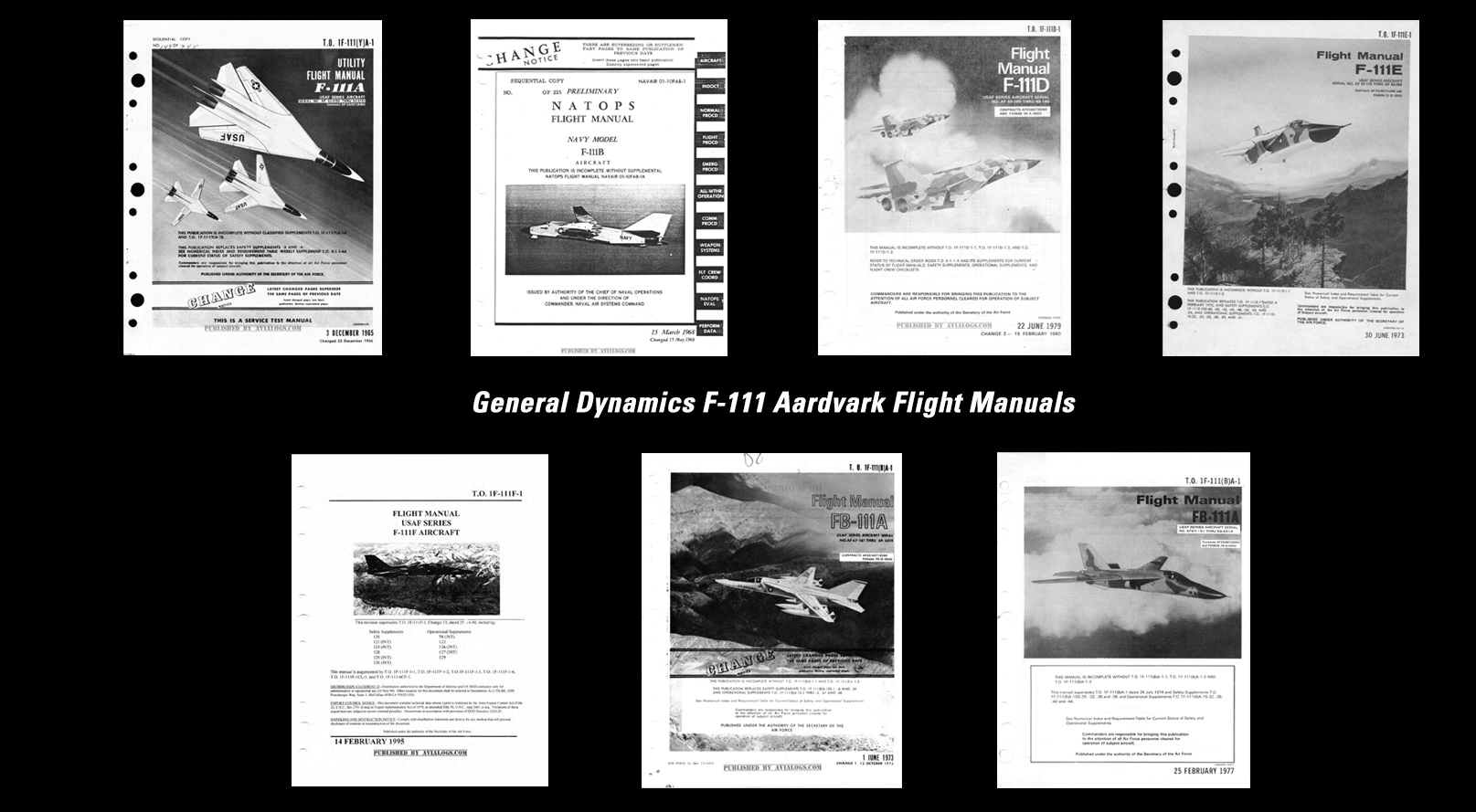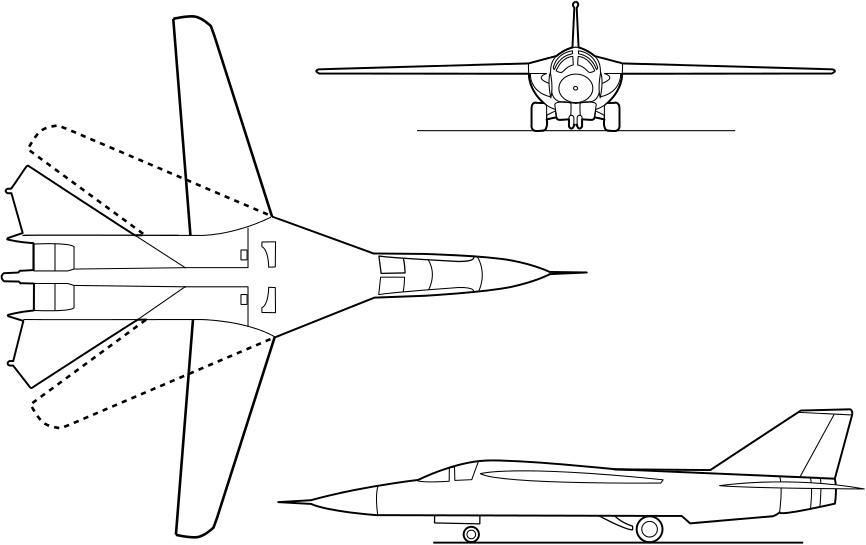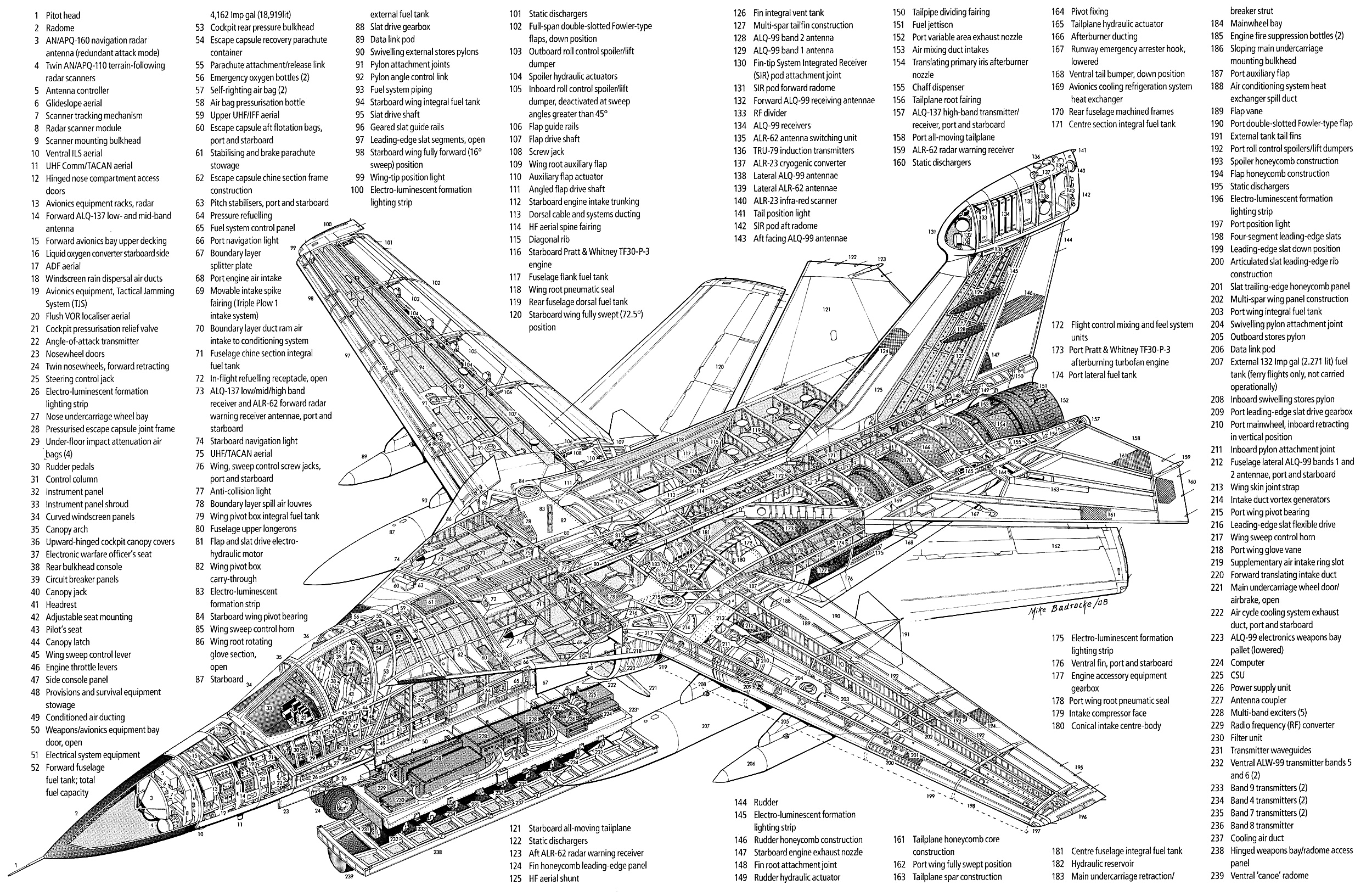Price: $29.95
- 8 magazines, 7 manuals, & photos
- PDF contains 3,668 pages
- Content is keyword searchable
- Print a personal copy
- Pay via PayPal or Credit Card
- International orders welcome!
- Download files upon payment
June 1979
- Can the F-111 Replace the B-1?
- Flying the B-25 in the Pacific
- Boeing’s XB-15 Long Range Bomber
July 1979
- Can the F-111 Replace the B-1? Part II
- Spectacular Carrier Crashes
- Allied Aircraft captured by the Germans
August 1979
- New combat role for the F-111 Fighter-Bomber
- Flying Tiger: Myth, Legend, Reality?
- Demon in the Dark, Heinkel’s 219 Owl
June 1987
- EF-111 Raven, Escort Without Arms!
- Making of the Carrier Strike Force
- WWII and the Coming of the Jets
- What’s new in Electronic Warfare?
September 1988
- Flying an F-111 at Red Flag
- Squadron Commander’s look at the Libyan Destroyer
- Schneider Cup Glory Years
April 1992
- Farewell to the F-111
- Interview with Combat Ace, Marion Carl
September 2004
- Swing Wings, X-5 to F-14
- North American’s Incredible XF-108!
- Lockheed Vega, Factory Fresh
- Itazuke Air Base Ramp Tour
December 2006
- F-111s in Vietnam
- Army Missiles, Models of Yesteryear
- Convair B-58, Factory Fresh
- Record Breakers… Higher, Faster, Farther
Manuals & Photos
- F-111A Flight Manual, 1965
- F-111B Flight Manual, 1968
- F-111D Flight Manual, 1979
- F-111E Flight Manual, 1973
- F-111F Flight Manual, 1995
- FB-111A Flight Manual, 1973
- FB-111A Flight Manual, 1977
- 295 F-111 Aardvark photos!
General Dynamics F-111 Aardvark
F-111F Specifications
Variants
On Display
F-111 Cutaway
EF-111 Cutaway
General Characteristics
- Crew: two (pilot and weapons system operator)
- Length: 73 ft 6 in (22.4 m)
- Wingspan: Spread: 63 ft (19.2 m), Swept: 32 ft (9.75 m)
- Height: 17.13 ft (5.22 m)
- Wing area: Spread: 657.4 ft² (61.07 m²), Swept: 525 ft² (48.77 m²)
- Airfoil: NACA 64-210.68 root, NACA 64-209.80 tip
- Empty weight: 47,200 lb (21,400 kg)
- Loaded weight: 82,800 lb (37,600 kg)
- Max. takeoff weight: 100,000 lb (45,300 kg)
- Powerplant: 2 × Pratt & Whitney TF30-P-100 turbofans
- Dry thrust: 17,900 lbf (79.6 kN) each
- Thrust with afterburner: 25,100 lbf (112 kN) each
- Zero-lift drag coefficient: 0.0186[171]
- Drag area: 9.36 ft² (0.87 m²)
- Aspect ratio: spread: 7.56, swept: 1.95
Performance
- Maximum speed: Mach 2.5 (1,650 mph, 2,655 km/h) at altitude; Mach 1.2 (915 mph, 1,473 km/h) at sea level
- Ferry range: 3,700 mi (3,210 nmi, 5,950 km) ; with external drop tanks
- Service ceiling: 66,000 ft (20,100 m)
- Rate of climb: 25,890 ft/min (131.5 m/s)
- Wing loading: Spread: 126.0 lb/ft² (615.2 kg/m²), Swept: 158 lb/ft² (771 kg/m²)
- Thrust/weight: 0.61
- Lift-to-drag ratio: 15.8
Armament
- Guns: 1× 20 mm (0.787 in) M61A1 Vulcan 6-barreled Gatling cannon in weapons bay (seldom fitted)
- Hardpoints: 9 in total (8× under-wing, 1× under-fuselage between engines) plus 2 attach points in weapons bay with a capacity of 31,500 lb (14,300 kg)
Bombs
- Free-fall general-purpose bombs including Mk 82 (500 lb/227 kg), Mk 83 (1,000 lb/454 kg), Mk 84 (2,000 lb/907 kg), and Mk 117 (750 lb/340 kg)
- BLU-109 (2,000 lb/907 kg) hardened penetration bomb
- Paveway laser-guided bombs, including 2,000 lb (907 kg) GBU-10, 500 lb (227 kg) GBU-12 and GBU-28, specialized 4,800 lb (2,200 kg) penetration bomb
- BLU-107 Durandal runway-cratering bomb
- GBU-15 electro-optical bomb
- AGM-130 stand-off bomb
F-111A
The F-111A was the initial production version of the F-111. Early A-models used the TF30-P-1 engine. Most A-models used the TF30-P-3 engine with 12,000 lbf (53 kN) dry and 18,500 lbf (82 kN) afterburning thrust and “Triple Plow I” variable intakes, providing a maximum speed of Mach 2.3 (1,450 mph, 2,300 km/h) at altitude.The variant had a maximum takeoff weight of 92,500 lb (42,000 kg) and an empty weight of 45,200 lb (20,500 kg).
The A-model’s Mark I avionics suite included the General Electric AN/APQ-113 attack radar mated to a separate Texas Instruments AN/APQ-110 terrain-following radar lower in the nose and a Litton AJQ-20 inertial navigation and nav/attack system. The terrain-following radar (TFR) was integrated into the automatic flight control system, allowing for “hands-off” flight at high speeds and low levels (down to 200 ft).
Total production of the F-111As was 158, including 17 pre-production aircraft that were later brought up to production standards. 42 F-111As were converted to EF-111A Ravens for an electronic warfare tactical electronic jamming role. In 1982, four surviving F-111As were provided to Australia as attrition replacements and modified to F-111C standard; these were fitted with the longer-span wings and reinforced landing gear of the C-model.
Three pre-production F-111A were provided to NASA for various testing duties. The 13th F-111A was fitted with new wing designs for the Transonic Aircraft Technology and Advanced Fighter Technology Integration programs in the 1970s and 1980s. It was retired to the United States Air Force Museum at Wright-Patterson Air Force Base in 1989. The remaining unconverted F-111As were mothballed at Aerospace Maintenance and Regeneration Center at Davis-Monthan Air Force Base in June 1991.
F-111B
The F-111B was to be a fleet air defense (FAD) fighter for the U.S. Navy, fulfilling a naval requirement for a carrier-based fighter aircraft capable of carrying heavy, long-range missiles to defend aircraft carriers and their battle groups from Soviet bombers and fighter-bombers equipped with anti-ship missiles. General Dynamics, lacking experience with carrier-based aircraft, partnered with Grumman for this version. F-111B suffered development issues and Navy requirements changed to an aircraft with maneuverability for dogfighting. The swing-wing configuration, TF-30 engines, AIM-54 Phoenix air-to-air missiles and AWG-9 radar developed for this aircraft were used on its replacement, the Grumman F-14 Tomcat. The Tomcat would be large enough to carry the AWG-9 and Phoenix weapons system while exceeding the F-4’s maneuverability.
F-111C
The F-111C is the export version for Australia, combining the F-111A with longer F-111B wings and strengthened FB-111A landing gear. Australia ordered 24 F-111s and, following delays, the Royal Australian Air Force accepted the aircraft in 1973. Four were converted to the RF-111C reconnaissance variant in 1979-80. Australia also purchased four ex-USAF F-111As and converted them to C standard. F-111C aircraft received avionics, weapons system and other upgrades during their time in service. The RAAF retired its last F-111Cs in December 2010.
F-111D
The F-111D was an upgraded F-111A equipped with newer Mark II avionics, more powerful engines, improved intake geometry, and an early glass cockpit. The variant was first ordered in 1967 and delivered from 1970-73. The F-111D reached initial operational capability in 1972. Deliveries were delayed due to avionics issues. 96 F-111Ds were built. The sole operator of this variant was the 27th TFW stationed at Cannon AFB, New Mexico.
The F-111D used the new Triple Plow II intakes, which were located four inches (100 mm) further away from the airframe to prevent engine ingestion of the sluggish boundary layer air that was known to cause stalls in the TF30 turbofans. It had more powerful TF30-P-9 engines with 12,000 lbf (53 kN) dry and 18,500 lbf (82 kN) afterburning thrust.
The Mark II avionics were digitally integrated microprocessor systems, some of the first used by the USAF, offering tremendous capability, but substantial problems. The Rockwell Autonetics digital bombing-navigation system included inertial navigation system, AN/APQ-130 attack radar system and Doppler radar. It also included digital computer set and multi-function displays (MFDs). The terrain-following radar was the Sperry AN/APQ-128. The attack radar featured a Doppler beam-sharpening, moving target indication (MTI), and Continuous-wave radar for guiding semi-active radar homing missiles.
It took years to improve the reliability of the avionics, but issues were never fully addressed. The F-111D was withdrawn from service in 1991 and 1992.
F-111E
The F-111E was a simplified, interim variant ordered after the F-111D was delayed. The F-111E used the Triple Plow II intakes, but retained the F-111A’s TF30-P-3 engines and Mark I avionics. The weapon stores management system was improved and other small changes made.
The E-model was first ordered in 1968 and delivered from 1969-71. It achieved initial operational capability in 1969. The variant’s first flight occurred on 20 August 1969. 94 F-111Es were built. Some F-111Es were based in the UK until 1991. The avionics were upgraded on some E-models as part of an Avionics Modernization Program. The variant served in 1990-91 during the Gulf War. Some F-111Es received improved TF30-P-109 engines in the early 1990s. All F-111Es were retired to AMARC by 1995.
F-111F
The F-111F was the final F-111 variant produced for Tactical Air Command, with a modern, but less expensive, Mark IIB avionics system. The USAF approved development of the variant in 1969. It also included the more powerful TF30-P-100 engine and strengthened wing carry through box. 106 were produced between 1970 and 1976.
The F-111F’s Mark IIB avionics suite used a simplified version of the FB-111A’s radar, the AN/APQ-144, lacking some of the strategic bomber’s operating modes but adding a new 2.5 mi (4.0 km) display ring. Although it was tested with digital moving-target indicator (MTI) capacity, it was not used in production sets.[101] The Mark IIB avionics combined some Mark II components with FB-111A components, such as the AN/APQ-146 terrain-following radar. The F-111E’s weapon management system was also included.
The F-model used the Triple Plow II intakes, along with the substantially more powerful TF30-P-100 turbofan with 25,100 lbf (112 kN) afterburning thrust, 35% more thrust than the F-111A and E. An adjustable engine nozzle was added to decrease drag. The P-100 engine greatly improved the F-111F’s performance. The engines were upgraded to the TF30-P-109 version, later in the 1985–86 timeframe.
In the early 1980s, the F-111F began to be equipped with the AVQ-26 Pave Tack forward looking infrared (FLIR) and laser designator system, which provided for the delivery of precision laser-guided munitions and was mounted in the internal weapons bay. The Pacer Strike avionics update program replaced analog equipment with new digital equipment and multi-function displays. The last USAF F-111s were withdrawn from service in 1996, replaced by the McDonnell Douglas F-15E Strike Eagle.
F-111K
The British government canceled the BAC TSR-2 strike aircraft in 1965, citing the lower costs for the TFX and ordered 50 F-111K aircraft in February 1967 for the Royal Air Force. The F-111K was to be supplemented later by the Anglo-French Variable Geometry Aircraft then under development. The F-111K was based on the F-111A with longer F-111B wings, FB-111 landing gear, Mark II navigation/fire control system, and British supplied mission systems. Other changes included weapons bay modifications, addition of a centerline pylon, a retractable refueling probe, provisions for a reconnaissance pallet, and a higher gross weight with the use of FB-111A landing gear.
In January 1968, the United Kingdom terminated its F-111K order,[110] citing higher cost; increased costs along with devaluation of the pound had raised the cost to around £3 million each.[111] The first two F-111Ks (one strike/recon F-111K and one trainer/strike TF-111K) were in the final stages of assembly when the order was canceled. The two aircraft were later completed and accepted by the USAF as test aircraft with the YF-111A designation.
FB-111A/F-111G
The FB-111A was a strategic bomber version of the F-111 for the USAF Strategic Air Command. With Air Force’s Advanced Manned Strategic Aircraft program proceeding slowly, and concerns of fatigue failures in the B-52 fleet, the service needed an interim bomber quickly. The FB-111A was selected in 1965 to replace the supersonic Convair B-58 Hustler and early B-52 variants. The Air Force signed a contract for the FB-111A in 1966. In 1968, plans called for 263 FB-111s, but the total was cut to 76 in 1969. The first production aircraft flew in 1968. Deliveries ended in June 1971.
When the UK canceled its order for the F-111K in 1968, components for the 48 F-111Ks in manufacturing were diverted to FB-111A production. The FB-111A featured longer F-111B wings for greater range and load-carrying ability. The bomber variant was lengthened 2 ft 1 in (63 cm) over the F-111A. Its fuel capacity was increased by 585 gallons (2,214 L) and it had stronger landing gear to compensate for the higher maximum takeoff weight of 119,250 lb (54,105 kg). All but the first aircraft had the Triple Plow II intakes and the TF30-P-7 with 12,500 lbf (56 kN) dry and 20,350 lbf (90 kN) afterburning thrust.
The FB-111A had new electronics, known as the SAC Mark IIB avionics suite. For the FB-111A the system used an attack radar improved from the F-111A’s system, along with components that would be used on the F-111D, including the inertial navigation system, digital computers, and multi-function displays. Armament for the strategic bombing role was the Boeing AGM-69 SRAM (short-range attack missile); two could be carried in the internal weapons bay and four more on the inner underwing pylons. Nuclear gravity bombs were also typical FB armament. Fuel tanks were often carried on the third non-swivelling pylon of each wing. The FB-111A had a total weapon load of 35,500 lb (16,100 kg).
Multiple advanced FB-111 strategic bomber designs were proposed by General Dynamics in the 1970s. The first design, referred to as “FB-111G” within the company, was a larger aircraft with more powerful engines with more payload and range. The next was a lengthened “FB-111H” that featured more powerful General Electric F101 turbofan engines, a 12 ft 8.5 in longer fuselage and redesigned, fixed intakes. The rear landing gear were moved outward so armament could be carried on the fuselage there. The FB-111H was offered as an alternative to the B-1A in 1975. The similar FB-111B/C was offered in 1979 without success.
The FB-111A became surplus to SAC’s needs after the introduction of the B-1B Lancer. The remaining FB-111s were subsequently reconfigured for tactical use and redesignated F-111G. The conversions began in 1989 and ended after 34 F-111G conversions were completed. With the disestablishment of SAC, the FB-111As and F-111Gs were transferred to the newly established Air Combat Command (ACC). They were used primarily for training. The remaining FB-111As were retired in 1991 and the F-111Gs were retired in 1993.Australia bought 15 F-111Gs in 1993 to supplement its F-111Cs. They were retired in 2007.
EF-111A Raven
To replace the aging Douglas EB-66, the USAF contracted with Grumman in 1972 to convert 42 existing F-111As into electronic warfare aircraft. The EF-111A can be distinguished from the F-111A by the equipment bulge atop their tails. In May 1998, the USAF withdrew the final EF-111As from service, placing them in storage at Aerospace Maintenance and Regeneration Center (AMARC).
Australia
- F-111G
- A8-272 – RAAF Museum, Melbourne, Victoria
- A8-134 – South Australian Aviation Museum, Adelaide, South Australia
- A8-148 – Fighterworld Aviation Museum, Williamtown NSW
United Kingdom
- F-111E
- 67-0120 – American Air Museum, Imperial War Museum Duxford, Duxford, England The last 20th Tactical Fighter Wing F-111E in the UK. It was directly transferred from USAF service at RAF Upper Heyford to the museum in late 1993, prior to the base closure in 1994.
- 68-0011 – RAF Lakenheath, England (gate guard, marked as 48th TFW F-111F)
- F-111F
- 74-0177 – National Cold War Exhibition, Royal Air Force Museum Cosford
United States
- F-111A
- 63-9766 – Air Force Flight Test Center Museum, Edwards AFB, California (first F-111)
- 63-9767 – Octave Chanute Aerospace Museum (former Chanute AFB), Illinois
- 63-9771 – Cannon AFB, Clovis, New Mexico
- 63-9773 – Sheppard AFB Air Park, Sheppard AFB, Texas
- 63-9775 – United States Space and Rocket Center, Huntsville, Alabama
- 63-9776 – Mountain Home AFB, Idaho (the only RF-111A, marked as 66-0022)
- 63-9778 – Air Force Flight Test Center Museum, Edwards AFB, California (TACT/AFTI F-111)
- 66-0012 – American Airpower Museum, Long Island, New York
- 67-0046 – Brownwood Regional Airport, Brownwood, Texas
- 67-0047 – Sheppard AFB Air Park, Sheppard AFB, Texas
- 67-0051 – Historic Aviation Memorial Museum, Tyler Pounds Regional Airport, Texas (marked as 67-0050)
- 67-0057 – Dyess Air Force Base Linear Air Park, Abilene, Texas
- 67-0058 – Carl Miller Park, Mountain Home, Idaho
- 67-0067 – National Museum of the United States Air Force, Wright-Patterson AFB, Dayton, Ohio
- 67-0069 – The Southern Museum of Flight, Birmingham, Alabama
- 67-0100 – Nellis Air Force Base, Nevada (aircraft display park)
- F-111C
- A8-130 Pacific Aviation Museum Pearl Harbor Former RAAF example
- F-111D
- 68-0140 – Cannon AFB, Clovis, New Mexico (F-111 “Vark” Memorial Park)
- F-111E
- 68-0009 – Fort Worth Aviation Museum,[148] Fort Worth, Texas
- 68-0020 – Hill Aerospace Museum, Hill AFB, Utah (nicknamed “My Lucky Blonde”)
- 68-0027 – Commemorative Air Force, Midland/Odessa, Texas
- 68-0033 – Pima Air and Space Museum (adjacent to Davis-Monthan AFB), Tucson, Arizona
- 68-0039 – Shaw AFB, South Carolina
- 68-0055 – Museum of Aviation, Robins AFB, Warner Robins, Georgia (nicknamed “Heartbreaker”)
- 68-0058 – Air Force Armament Museum, Eglin AFB, Florida
- FB-111A / F-111G
- 67-0159 – Aerospace Museum of California (FB-111A development aircraft)
- 68-0239 – former K.I. Sawyer AFB, Michigan (nicknamed the “Rough Night”)
- 68-0245 – March Field Air Museum, March ARB, Riverside, California (nicknamed “Ready Teddy”)
- 68-0248 – South Dakota Air and Space Museum, Ellsworth AFB, South Dakota (nicknamed “Free For All”)
- 68-0267 – Strategic Air and Space Museum (adjacent to Offutt AFB), Ashland, Nebraska(nicknamed “Black Widow”)
- 68-0275 – Kelly Field Heritage Museum, Lackland AFB / Kelly Field San Antonio, Texas (painted in tactical scheme)
- 68-0284 – Eighth Air Force Museum, Barksdale AFB, Louisiana[162]
- 68-0286 – Clyde Lewis Airpark (adjacent to former Plattsburgh AFB), Plattsburgh, NY(nicknamed “SAC Time”)
- 68-0287 – Wings Over the Rockies Air and Space Museum (former Lowry AFB), Denver, Colorado
- 69-6507 – Castle Air Museum (former Castle AFB), Atwater, California (nicknamed “Madam Queen”)
- 69-6509 – Whiteman AFB, Missouri (gate guard) (nicknamed “The Spirit of the Seacoast”)
- F-111F
- 70-2364 – In the median strip of U.S. Highway 70, in Portales, New Mexico
- 70-2390 – National Museum of the United States Air Force, Wright-Patterson AFB, Dayton, Ohio
- 70-2408 – Santa Fe, New Mexico Airport










